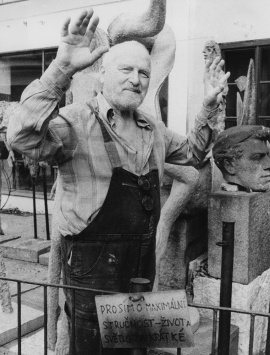
In his 91st year, sculptor Olbram Zoubek has passed away
Prague - Academic sculptor Olbram Zoubek passed away today in Prague at the age of 91. This was announced to ČTK by the director of the National Film Archive and Zoubek's son-in-law Michal Bregant. Among other works, Zoubek created a memorial to the victims of communism in Prague's Újezd. He came to the public's attention when, in 1969, he took the death mask of Jan Palach, who self-immolated in protest against the communist regime. Some government members described Zoubek as a great artist and person, a prominent figure, and a knight of Czech culture.
Zoubek himself said he considered himself a craftsman. "I like making living sculptures that belong to rain, frost, and wind," he told ČTK previously. The main theme of Zoubek's work was the human figure. His sculptures are characterized by slenderness and elongation as well as expressive gestures and postures. His work is represented in numerous Czech and foreign galleries and private collections.
The end of the 1960s interrupted Zoubek's artistic life, during which he created the death mask and tombstone of student Jan Palach. "It's called a challenge, that’s what I felt when Jan Palach died. It was a turning point in my life; I felt that I could no longer live as before. So I thought that I could offer a service that only a few people know how to provide, or are willing to do, which is taking his death mask," he said to ČTK last year.
Zoubek then became uncomfortable for the regime, and during the following period of normalization, he had limited opportunities for public activity. He then worked, for instance, as a restorer in Litomyšl. After November 1989, according to Bregant, he actively participated in democratic changes. He was a member of the arts section of the Artistic Society, an artistic association that was established in the 19th century, and whose activities were renewed in the 1990s after years of restricted work of the society under communism.
The Minister of Culture Daniel Herman (KDU-ČSL) considers Zoubek's departure a huge loss. He described him as a Knight of Czech culture. "Olbram Zoubek was among those artists for whom I appreciated a high degree of professionalism and the purity of moral profile," he stated to ČTK. About how Zoubek managed to combine professionalism and moral qualities, the chairman of the Christian Democratic Party Pavel Bělobrádek wrote on Twitter. Zoubek was a great artist and person for both Bělobrádek and presidential candidate Jiří Drahoš. "We can only say - Thank you, and we will not forget!" Drahoš wrote on Twitter.
According to Prime Minister Bohuslav Sobotka (ČSSD), Zoubek has made an indelible mark on the history of Czech culture. "Czech art has lost one of its most prominent personalities today," the Prime Minister wrote on Twitter.
With great sorrow, art patron Meda Mládková received the news of Zoubek's death. Zoubek had been one of her close friends since the late 1960s when she began visiting then-Czechoslovakia, reported Jiří Pospíšil, chairman of the board of the Jan and Meda Mládek Foundation, to ČTK. "She appreciated him not only as an artist but also for his civic stance," he stated.
Sculptor Kurt Gebauer especially values Zoubek's work from the 60s and 70s when Zoubek and his first wife Eva Kmentová worked on abstract figuration. According to Gebauer, Zoubek was one of the sculptural models alongside Karel Nepraš, Aleš Veselý, and others during that time.
Zoubek later transitioned to the style he is known for after a visit to Greece. "It inspired him in some way to the figures that are more well-known, those are the figures with drapery and expressive gestures," Gebauer noted on Czech Television. He emphasized, however, that "the most important" work Zoubek did was in the 60s and 70s. He also recalled that before the November revolution in 1989, an intergenerational New Group met in Zoubek's studio, which defined itself against the official policies of the Union of Czech Visual Artists.
Recently, Zoubek worked on a sculpture of Father Josef Toufar, which was unveiled this February in the church in Zahrádka near Havlíčkův Brod. Zoubek began creating the figure of the priest, who was tortured by the communists, after reading books by Miloš Doležal. "It touched me so much that I decided to do it. For myself. And if it turned out well, I would dedicate it to Číhošť or rather to Zahrádka," he stated before completing the work.
People can currently see Zoubek's work, for example, at exhibitions at the Church of St. Lawrence in Klatovy until June 18 or at the Museum of Beroun Ceramics in Beroun until June 25. A large retrospective exhibition prepared by Zoubek himself was visited by nearly 38,000 people at the Riding School of Prague Castle at the turn of 2013 and 2014.












